For many years now I have been boring my friends to distraction with my obsession with salt. If the conversation flagged over dinner at any point, I could always be counted upon to regale them with an account of how the French and American Revolutions, or Indian Independence, began with salt issues. Or, I would point out the linguistic route of the word 'salary', or that Salzburg was a mountain of rock salt. I would also note for their delectation that our bodies need an astonishing 250 grams of salt in them to be healthy. In short, I am a salt mine of information which is little or no use to anyone except me. Friends and relations therefore often bring me salty pieces of information confident that they will elicit firm interest. So when my friend Justin directed my attention to the magnificent French royal saltworks at Arc et Senans, built in the last quarter of the 18th century by the architect Claude-Nicolas Ledoux, I was eager to visit. It has taken me nearly 10 years to do so but I am finally on my way.
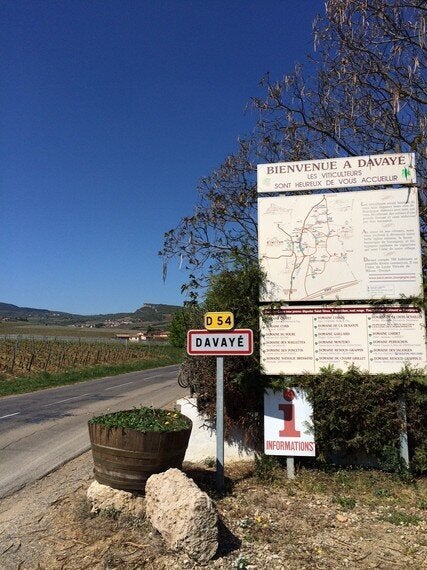
I am driving as I also have a second pilgrimage to fulfil. Together with Felicity, my dear friend and former work colleague from Mallett, I used to drink a lot of a white wine called Mâcon Davaye. In the days of Mallett at Bourdon House, when we needed a bottle of wine in a hurry we used to run up the road to Laytons Wine Merchant. They were always helpful and charming and encouraged us to try different things. One time they offered me a Mâcon Davaye as it was being discounted, and they also rated it - it was a promotion rather than a disposal strategy. It was delicious and very reasonably priced. Felicity and I bought all their remaining stock, and begged them to source more. Over a couple of years we drank it as much as we could. But the price rose, moving it from everyday drinking into the territory of treat, then to special treat, and finally to out of the question. My Davaye days were over. But I retained a nostalgic love of the mineral, fruity and flowery flavour and I have hankered after returning it to my drinking fold. The area around Mâcon is home to St Veran and Pouilly-Fuissé as well, so it made sense to join up the obsession with salt with a few days pouring aromatic wines down my willing and welcoming throat and filling the car with delights for London.
My adventure has its first pit stop in the Grand Place in Arras. This is a market square that compares to the great Grand Place in Brussels but is nothing like as famous. It is not as glittery as its Brussels namesake but it is very coherent, consistent and extremely large. Where the square in Brussels can claim to be a world famous tourist attraction, the one in Arras serves principally as a weekly food market and the town's main car park. Poor Arras. Or lucky Arras?! Walking round this charming but largely overlooked medieval market town the silence was broken by the distinctive low heavy growl of Harley Davidsons. It turned out to herald a biker wedding and the party were roaring round the squares hooting their horns and revving their engines. The locals seemed to take it in their stride with hardly a turned head but I was bewitched by their huge bikes and their wedding clothes. The tableau presented itself as an updated medieval wedding with horses and carts, the uproar was timeless and wonderfully appropriate and uplifting.
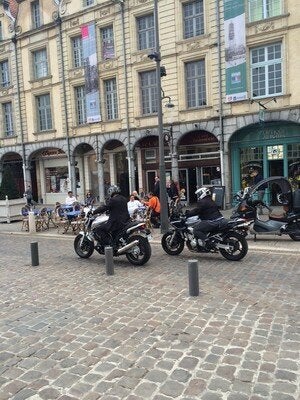
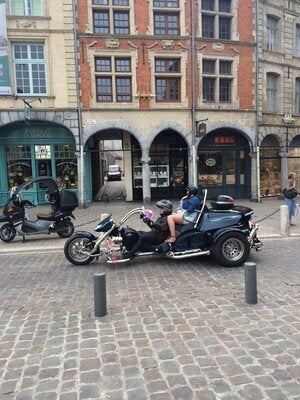
In Burgundy on Sunday I spotted a small 'vide grenier' in the picturesque village of Riel-les-Eaux - even though antique dealing is my job I cannot resist doing it as a hobby too. I bought a delightful 19th-century rummer for 20 cents and an 18th-century Chinese export plate for 2 euros. It was a warm and friendly day and the locals all teased me by saying everything I looked at was once owned by the English royal family. Lady Diana had used and been very fond of all the pewter plates of one trader, another was certain Prince Charles loved using his cracked and aged pottery coffee bowl and I could acquire it for a mere 2 euros. Who could resist?
Driving down into the Jura, famed for its Vin Jaune, was splendid as wide open, rape-filled fields gave way to hilly alpine scenery with half-timbered chalets. Then back into flat lands for the approach to the salt works. Needless to say I arrived during lunch - the site was closed. In France the period of lunch is still sacrosanct. So I sat in the sunshine and ate a baguette sandwich of ham and the local Comte cheese washed down with a dark, almost red, rose. As I munched, I looked across at the entrance, with its round windows carved as amphora issuing gushing water like the attribute of a Roman river god, and the temple-fronted Guard House, reputedly based on Ledoux's studies of the temples at Paestum, with a dramatic, craggy, arch like in an Italian grotto but symbolising rock salt, I knew I was going to fall in love with this semi-circle of extraordinary buildings. The structures are famous for their pioneering and powerful neo-classical designs but, there are also elements exhibiting a strong agricultural character. This may have given Ledoux's contemporaries reassurance through a sense of familiarity and recognition, as the neo-classical mode must have seemed very shocking almost revolutionary. Ledoux has been cited as a Utopian, someone who saw that industrial buildings might have the potential to actually engender a better quality of life for those who worked in them or simply encountered them. Around the Royal Salt Works he envisaged a model town, with factories and public buildings, all designed in the new fashion and fashioned in exotic shapes. Constructed and conceived around optimistic and healthy lines which would bring the workers both happiness and greater productivity. Only what we see today was built, but his more extensive designs for the salt works, together with designs for other schemes are on show at the site. They are thrilling and truly visionary. Sadly none of the actual salt-producing machinery survives but the buildings and the philosophy they illustrate truly justify their UNESCO World Heritage Site designation.
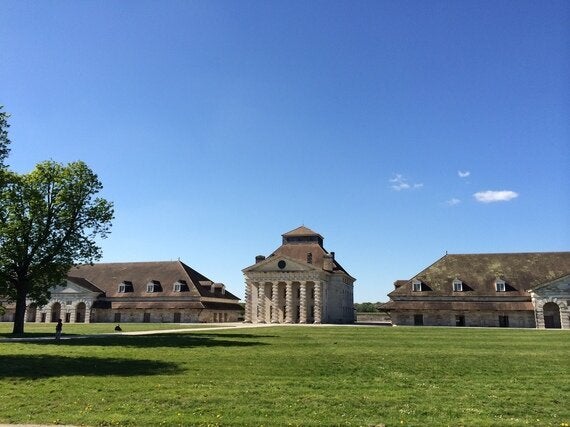
The town of Mâcon, cut through by the river Saône in slow, wide and stately mode, gives its name to a plethora of wines. Two days were spent quaffing and climbing, beginning with the rock at Solutré, which was used as a place of refuge and a look-out by people living in the region over 50,000 years ago. Standing on its peak, vineyards stretch out in all directions as far as the eye can see. Tasting is an arduous and absorbing task and I forgot to eat lunch and ended up eating an emergency Mars Bar stuffed into the glove compartment by the Eurotunnel in! But I got to Davaye, Lugny and Pouilly, where I bought some dozens and half dozens and weighed the car down until the steering and brakes became unhealthy. All the Domaines are interwoven in their grape production and they all claim that their methods of production are the same, but apart from the bare bones of the taste, they differ wildly in all the details of the balance between the flavours. I am looking forward to revisiting the experiences in London.
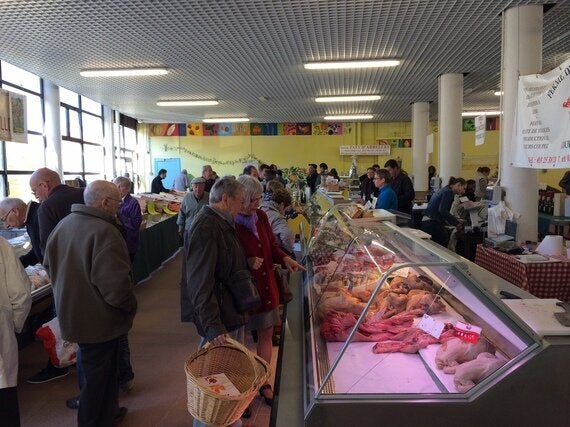
My last treat of the trip was the market in Chatillon-sur-Seine. Occupying a utilitarian post-war shed, 20 or so food producers display their wares every Saturday. They start at 8 and by midday nearly everything has gone. The smiling bread man has his child with him and looks fashionable with a pony tail and an unshaven face. The butcher is old-school with a belly and blood on his apron, whilst outside a pretty middle aged woman trumpets the freshness and moist nature of her fruit-infused Macaroons. This is a classic market. I buy goat's cheese, dried magret de canard flavoured with herbs and ground pepper, and a half kilo of fresh prawns in their shells. These are quickly consumed over lunch with chilled wine from Mâcon and Easter ends with a long, careful and slightly unsteady drive back to London.
